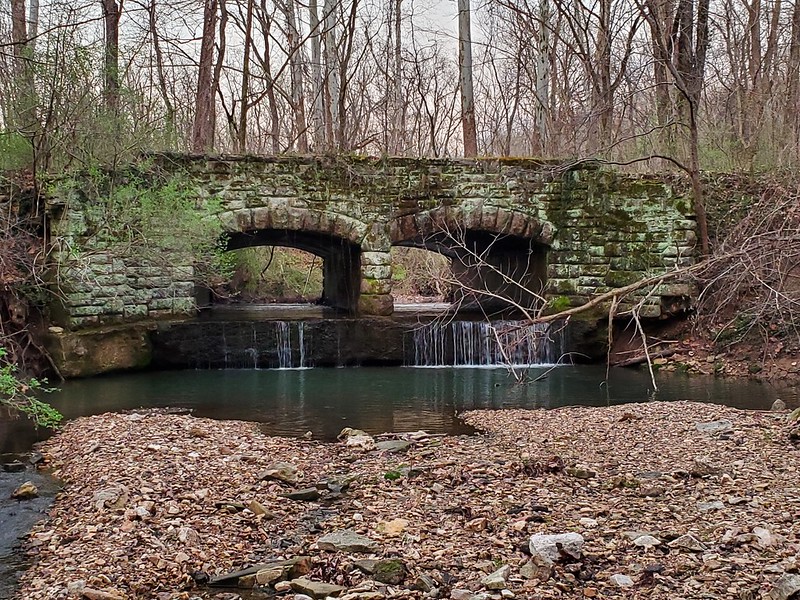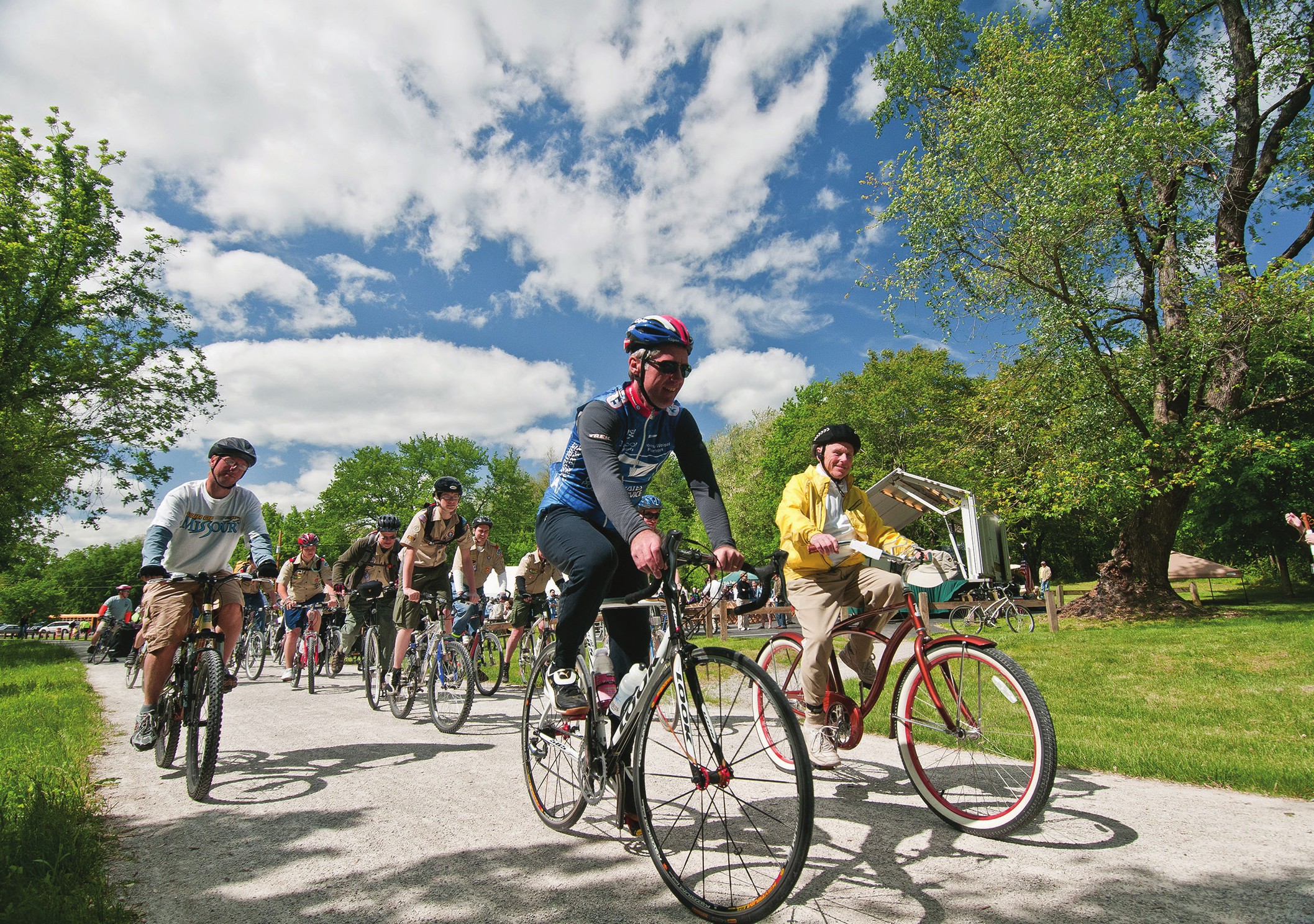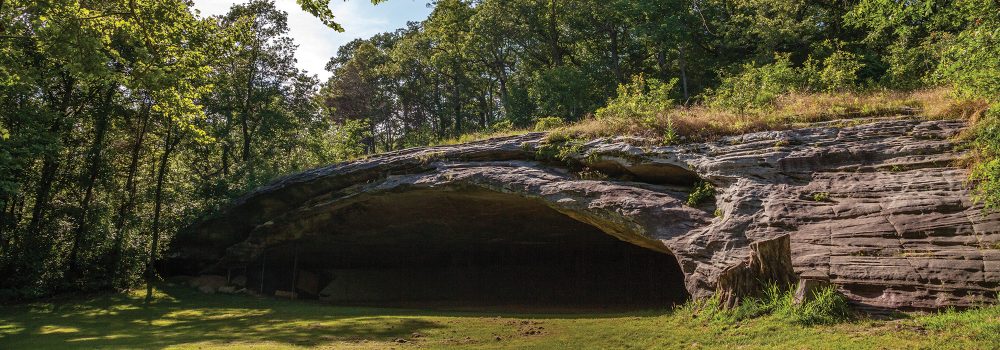By foot is the best way to see Pickle Creek, sandstone landscapes, shut-ins, and distinctive flora. Rose azaleas accent fern-covered ledges and Whispering Pine Wild Area beckons you to discover the wonders this State Park has to offer.
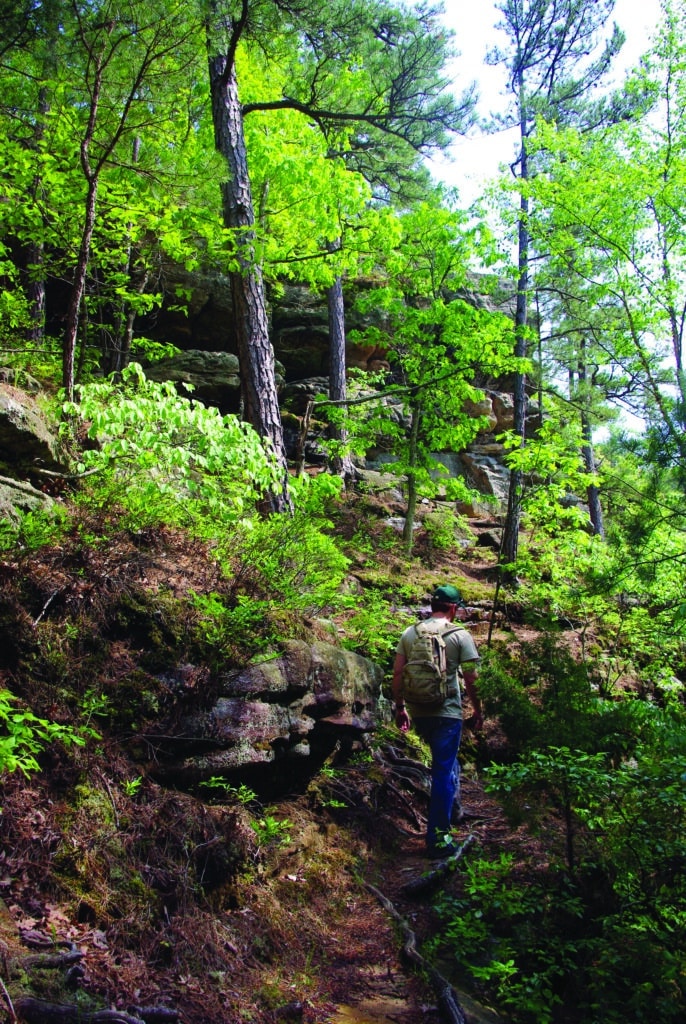
Photo credit Ron Colatskie.
SOME STATE PARKS CAN BE EXPERIENCED by canoe, by motorboat, by car, or by trail bike, but there is only one way to really take in the pleasures of Hawn State Park, and that is by foot. True, the campgrounds and picnic areas, some of the most pleasant in the park system, are accessible by automobile. But to see the bulk of this park and to savor its riches, the visitor must leave the family sedan behind and strike out across the sandy forest floor, strewn with pine needles.
Arriving by car at the northern end of this foot-traveler’s park in the rugged hills of western Ste. Genevieve County, you are treated to one of the loveliest vistas in the state. After passing the park office, the entrance road turns south and descends a steep slope to the campground and picnic area located in the valley of Pickle Creek. The rolling forested hills of the eastern Ozark Border provide a wide-angle, wind- shield-framed spectacle that immediately tells you that this place is something special.
Hawn State Park preserves Missouri’s most exemplary concentration of distinctive Lamotte sandstone landscape features. Lamotte is the name of the very old, coarse-grained sandstone formation that overlies the ancient igneous rocks of the Precambrian era. The Lamotte is composed of sands weathered from the Precambrian granites, and its sculpted outcrops provide a contrast to the more usual dolomites and limestones that poke through most of Missouri’s landscape. The park’s principal streams, Pickle Creek and River aux Vases, have carved steep-sided ravines into the thick beds of the Lamotte, reaching the more erosion-resistant igneous rock in places to create shut-ins.
The unique ability of this sandstone to hold groundwater moisture and to produce acidic soils allows for distinctive flora. The park supports a mixed pine and hardwood forest and a whole assembly of unusual and rare plants. In some places the oak and pine forest gives way to pure stands of mature shortleaf pine—Missouri’s only native pine. These stands are among the finest anywhere in the state. Parts of the park have a forest floor literally carpeted with needles over the whitish sands of the Lamotte.
Prior to settlement, the park was covered with enormous pines, some of their trunks measuring four feet thick. Much of the landscape was more open than it is today, mantled in a mosaic of wildflowers and shrubs amid the pines. Visitors can visualize what some of the landscape must have looked like at the open pineries near the picnic shelter, around the amphitheater, and in the extensive grove at Botkin’s Pine Woods Natural Area.

Photo credit Tom Nagle
The park is beautiful year-round, but especially in the spring. Both dogwood and redbud are plentiful, and they are joined by the fragrant blossoms of the rose azalea, one of Missouri’s showiest flowering shrubs. Hawn is the only state park where you can find these azaleas. Along the sandstone bluffs, you may also find the rare eastern clubmoss called ground cedar (Lycopodium tristachyum). In Missouri, it has been found only in Ste. Genevieve County at three sites in and near the park.
In a few remote corners of the park, the erosive action of water on sandstone has produced box canyons that are cooler, damper, and shadier than the surrounding hillsides. These microhabitats provide refuge for plants and animals usually found in more northern states, left behind when the Ice Age glaciers retreated. They have become living museums.
Among the rich plant life are many species of ferns: cinnamon, royal, sensitive, lady, broad beech, bracken, Christmas, common polypody, bulblet, silvery, ebony, pinnatifid, marginal shield, and common woodfern, narrow-leaved and Scott’s spleenwort, and two rare species, hay-scented fern and spinulose shield fern. The beautiful showy orchids and other orchids are abundant; two of them are quite rare—green adder’s mouth and rattlesnake plantain. Other relics include partridgeberry and Canadian white violet.
Even the creeks themselves are special. Pickle Creek provides a distinctive habitat with its clear water, sandy bottom, shaded surface, and lack of much aquatic vegetation. Fish biologists report that the creek supports at least twenty species of fish—various minnows, darters, and shiners—even an occasional smallmouth bass. It has been designated an Outstanding State Resource Water, and nearly sixty acres of its corridor comprise the Pickle Creek Natural Area.
The diversity of the flora and fauna is important, probably more so to the scientist or naturalist than to the average park visitor. But almost everyone will recognize Hawn State Park as a distinctive natural setting. Park visitors will find opportunities for solitude and for primitive recreation. Recognizing the importance of these values, park officials have designated more than half of the park as the Whispering Pines Wild Area.
Hawn State Park is named for Helen Coffer Hawn, a rural Ste. Genevieve County public school teacher who lived with her mother and brother in a rented cottage but dreamed of creating a “little park” for the people of Missouri. Through her will after her death in 1952, she gave nearly 1,500 acres of magnificent wild hills and streams to the state. She had acquired them tract after tract in at least twelve separate purchases between 1932 and 1941 and had hoped to acquire still more that landowners were unwilling to sell, including the impressive columnar Chimney Rocks.
Development at Hawn was held up for more than a decade by the state’s inability to acquire the Chimney Rocks, which were thought at the time to be essential for “park appeal.” When the area was finally opened to the public, it was called an outdoor recreation area rather than a park, and the Park Board shared its management with the Conservation Department for timber-stand improvement and hunting as well as other recreation. After four years and a number of citizen complaints, the Park Board took over sole management. Thirty additional purchases by the state in the years since Helen Hawn’s extraordinary gift have brought the total holdings to almost 5,000 acres, still without the Chimney Rocks. But no one today would think of suggesting that Hawn lacks park appeal.
Motorists rarely discover the park accidentally; it is situated about halfway between Highway 67 and Interstate 55. For years, people learned of Hawn most often by word of mouth, and the visitors singing its praises were interested in less-developed recreational areas and appreciative of its natural amenities. Respecting that tradition and those values, park officials have exercised great care in developing the park. In addition to adding more acres to protect the watershed of Pickle Creek from encroaching development, they have kept the campground modest, avoided more elaborate accommodations, and limited trail use to pedestrians. Even so, the park attracts more than ninety thousand visitors a year and shows signs of wear, erosion, and loss of natural vegetation in places. You can help by staying on trails, resisting the temptation to climb on moss-and-lichen-covered slopes and ledges.
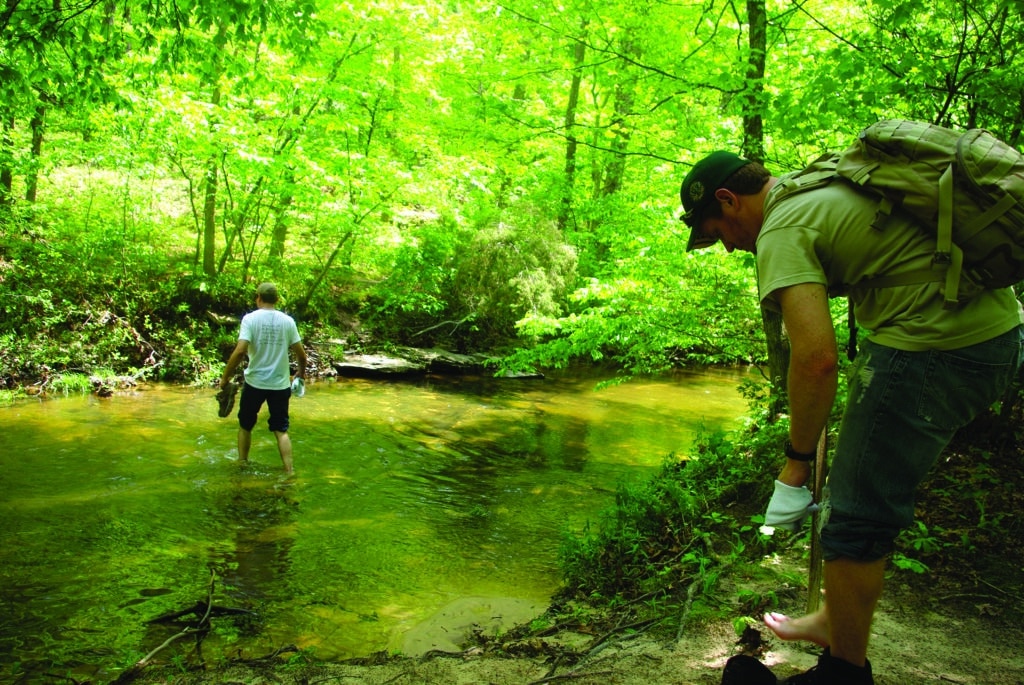
Photo credit Ron Colatskie
As park managers and visitors have come to appreciate the extraordinary natural qualities of the park, management goals have centered increasingly on landscape restoration and protection. There are four state-designated natural areas in the park, three of them within the wild area. With a beautiful trail along its length, Pickle Creek is the most readily accessible. Since the diverse flora and fauna of the pine and mixed woodlands on the Lamotte sandstone in this area developed and thrived by adapting to repeated wildfires, which were suppressed for many decades here and throughout the Ozarks, park managers began in 1988 to restore fire by prescribed burns, preceded in places by mechanical thinning of dense vegetation. Since then, they have conducted dozens of such burns in various areas of the park, both within the wild area and on lands more recently acquired, restoring a much more open, diverse understory. Scientists from nearby universities have conducted dozens of research and monitoring projects, many assessing diversity of species and responses to fire, making Hawn one of the most carefully studied of our state parks as well as one of the most beloved.
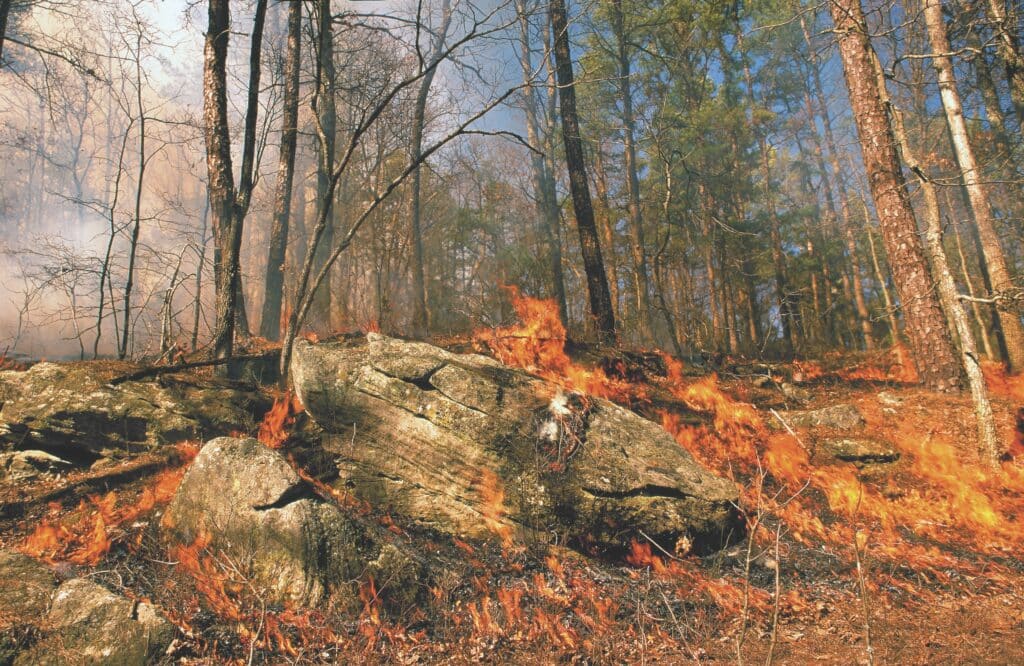
Photo credit Kevin Sink
If you hike about a mile south from the campground, the trail leads up a remnant erosional knob of sandstone called Evans Knob. You’re only about three hundred feet above Pickle Creek and not that far from the park comfort station, but standing there in that old forest—mostly white oak, shortleaf pine, and scarlet oak with a sprinkling of flowering dogwood and wild blueberry—you feel transported back in time, back to the mid-nineteenth century before this remote, rugged terrain was settled and when the nearest hint of spreading civilization was the old plank road several miles to the north (now Route 32). You are too far away to have heard the wagons hauling pig iron from Iron Mountain to the river at Ste. Genevieve, just as now you cannot hear the automobile traffic speeding between Farmington and Weingarten. Or you may be transported back further, to the days of ox-drawn French charettes hauling lead from Mine La Motte—named for Antoine de la Motte Cadillac, the governor of Louisiana who discovered the mine that in turn gave its name to the sandstone so characteristic in the region—or back even further, when Native Americans roamed free and stalked game in the piney woods. That is the magic of Hawn State Park.
HIKING AT HAWN
Hawn State Park features some of the finest hiking trails anywhere in the state. The Whispering Pines Trail, built and maintained with the cooperation of the Ozark Chapter of the Sierra Club, consists of two loops—one about six miles and the other less than four—and leads south toward the River aux Vases. A shorter trail leads up Pickle Creek from the picnic grounds to the scenic shut-ins. White Oaks Trail connects with both Pickle Creek and Whispering Pines Trails, leading hikers through a diverse mixed hardwood and shortleaf pine woodland. Hikers like the changing landscapes: terraced cliffs covered with ferns and moss, miniature terrarium-like gardens overhanging rock shelves along clear streams, shattered blocks of sandstone and volcanic talus, distant pine-clad hills, and uplands here and there broken by sandstone boulders and exposed slabs of bedrock.
HAWN STATE PARK • 12096 PARK DRIVE, STE. GENEVIEVE.
Discover more hidden gems in Southest Missouri here.
Find more great hiking and biking trails in Missouri here.
Related Posts
A True Gem of a State Park
Dedicated in 1938, this gem of a state park now sits amid an expanding suburban landscape and is worthy of a visit any time of year. There are twenty-two CCC-era structures to visit, rocky hills to hike, and massive trees to stop and rest under.
Get Out and Enjoy the Katy Trail State Park!
What was once the MKT (Missouri-Kansas-Texas) railroad,The Katy Trail State Park has so much to explore on foot, by bike, or on some stretches, horseback. The trail runs 240 miles over 14 counties. Get out and see the state in a whole new way.
Hiking Graham Cave State Park
Head over to Graham Cave State Park to walk in the footsteps of early Missourians.

